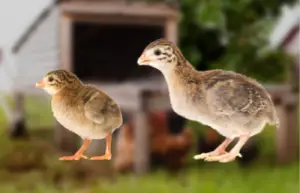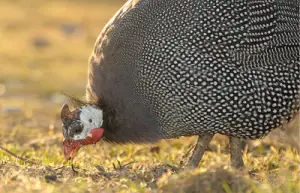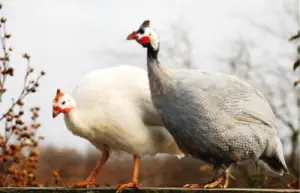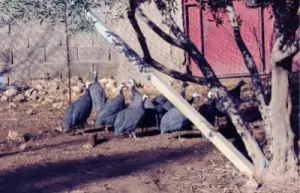How Much Guinea Fowl Cost
While chickens are typically the go-to option when purchasing farm poultry, guinea fowl offer a competitive, lower-maintenance option that comes with additional perks such as pest control and organic farm security. If you have painstakingly researched poultry options and decided to purchase a flock of guinea fowl, your next question might be: How much do they cost?
There are many factors that can affect the price of guinea fowl, such as the number you plan to purchase, age, pinioning, and the breed of the fowl, but, generally speaking, guinea fowl tend to cost between $3 and $8 per keet.
Keep reading to learn more about how much it costs to purchase and raise guinea fowl!
Factors That Determine The Cost of Guinea Fowl
Though $3-$8 reflects a general spectrum that guinea keets can typically be purchased for, there’s a variety of factors that can either lessen or raise the amount of money you’ll need to spend on the fowl. Age of the bird, breed of the bird, pinioning, and how many keets you plan to purchase can all influence the total cost of starting your guinea flock.
The Age of Guinea Fowl Can Impact Their Cost 
Though it is possible to buy guinea fowl as adults, it is not recommended due to the lack of control that you have over their initial environment. Guinea fowl are social creatures, and, as such, have a very vocal communication system. While their loud noises can serve as an organic security alarm, they can also be quite annoying if you live in a non-rural setting.
It is easier to control the birds’ noise levels when you raise them in a consistent environment from birth. This also applies to their general disposition and sociability. It is best to purchase your flock when they are all keets and to keep them in the same environment that they will eventually reside in.
However, if you are looking to replace a particular bird in your already-grown flock, or you just want a singular, adult guinea fowl to eat, it’s possible to purchase an adult bird. As you may have guessed, adult guinea fowl tend to be more expensive than keets. Adult guinea fowl tend to cost anywhere from $10 to $25, depending on the breed of the bird. Rare breeds, such as the Sky Blue or Lavender varieties, can cost upwards of $25 depending on the hatchery you purchase them from.
Before we move on, I’d like to address another downside to purchasing adult guinea fowl: They are hard to find! Day-old keets and hatching eggs alike can easily be shipped overnight due to their small size and ability to be without food or water for short amounts of time.
Older adult guineas are much harder to ship as they require larger, more complicated packaging as well as constant food and water access. However, this problem is easily solved by purchasing adult guinea fowl in person from your local hatchery. Buying local may limit your choices when it comes to breeds, but ultimately, there are relatively few downsides if you can find a breeder close to your location.
Paying For Pinioning Can Increase the Cost of Guinea Fowl 
Guinea fowl, unlike other poultry farm animals, are extremely capable flyers. They can fly up to 500 feet high, which makes them relatively hard to contain in an outdoor, free-range environment. Pinioning is one solution to this containment problem. What is pinioning, you might ask? It’s the practice of snipping the top of a guinea fowl’s wings, taking away their ability to fly permanently. Unlike declawing or debarking, pinioning is a relatively common and humane practice that is usually performed on keets, not adult guineas.
Pinioning your keets is an excellent option if you don’t have an overhead, fenced-in area for your guinea fowl, but it can add extra costs to your initial purchase. Most hatcheries perform pinioning on young keets for an additional $0.10 to $0.35 per bird. This may not seem like a lot, but if you’re ordering a large batch of guinea fowl, the costs can add up quickly.
Depending on your individual situation, however, the initial cost of pinioning your keets may save you money in the long term by preventing your guinea fowl from fleeing your farm.
The Way Your Order Guinea Fowl Can Impact Their Cost
As with many products now, it’s always better to purchase guinea fowl keets in bulk. Most hatcheries offer discounts on individual keets if you’re purchasing more than 45 in one order. Buying in bulk can lower the cost of each guinea keet from $3.00 to around $1.50 at most hatcheries. Though this can help you save on the initial costs of purchasing your flock, it’s important that you have enough resources to support the birds and keep them happy before committing to the purchase. If you’re looking for more information on everything you need to successfully raise a flock of guinea fowl, check out my previous article “How Many Guinea Fowl To Get: What You Should Know” to learn more.
Shipping Guinea Fowl vs. Local Guinea Fowl Cost 
There are many benefits to ordering keets through an online retailer, such as a wide variety of guinea fowl breeds to choose from and more competitive per guinea prices. However, there can be additional hidden costs associated with shipping one-day-old keets, so let’s dive in!
Keets have to be shipped via priority mail. Depending on the online retailer you select, they may provide free shipping or charge the customer for the shipping expenses. Priority Mail shipping through USPS costs anywhere from $20 to $30, depending on the weight of the box you’re ordering. If you’re only purchasing six keets at $5 a keet, the cost of shipping can almost double your total expenses! Make sure that you clearly understand how shipping costs will be handled and who is responsible for them before making your purchase.
In addition to the added cost of shipping your keets, you may experience more additional keet loss during the process of shipping if you choose to order them online. Most hatcheries claim that they are not responsible for any losses accrued during the transportation process, meaning that the consumer takes full responsibility for any accidental keet deaths. Though keets are generally resilient and these losses have a low probability of occurring, it’s still important to acknowledge the possibility during shipment.
Now that I have discussed all the downsides to shipping day-old keets, let’s quickly touch on the upsides. Hatcheries can be few and far between; in fact, there are only two official hatcheries that sell day-old keets in the entire state of California. If you live in an area with few options for in-person keet pick-up, online ordering is definitely the way to go.
The $30 you spend on shipping may even be less than the cost of gas for a round-trip to your closest hatchery. There are also more options when it comes to guinea fowl breeds if you decide to ship your keets. Shipping versus in-store pick-up is a decision with pros and cons on every side. Ultimately, only you can make the best decision for your farm and keets.
Costs of Owning and Raising Guinea Fowl 
Though the initial price of each guinea fowl keet may seem like a steal, it’s important to factor in other expenses such as food, water, and shelter before deciding to purchase your flock. So, how much feed do guinea fowl require? And what will that cost?
Cost of Guinea Fowl Food
For the first five weeks of their life, guinea fowl need a high-protein feed mix. This is because they are growing and need plenty of nutrients to transition into healthy adulthood. Experts typically recommend a feed that has between 25% and 28% protein for keets of this age. It’s better to feed them a game bird mix at this point, then transition to chicken feed after they reach adulthood. Let’s start with a hypothetical that will help me break this down a bit more.
If I have six, day-old keets, I will need approximately 25lbs of feed per bird to ensure they grow into a healthy adult. 6 x 25 is 150lbs of feed necessary for the first five weeks of the flocks’ life. Each bag of feed comes in at roughly 50lbs and costs between $30 and $35 to purchase. In total, this means that I will have to spend around $90 to $105 to feed my keets after they arrive.
Once the keets reach around five weeks of age, it’s acceptable to switch to a lower protein feed; somewhere around 20% protein to be exact. Most chicken feeds contain this level of protein and are cheaper than game bird feed, so your costs to feed the birds should decrease during this time.
After your keets are eight weeks old, you can switch to an even lower protein feed, which you can continue feeding them after they enter adulthood. Typically, you want to go for something that has around 16% protein. Lower protein feed is equal to lower costs, so you will once again be mitigating feed costs compared to when the keets were younger. Chicken feed with 16% protein costs usually around $20 to $25 per 50lb bag. Once the guineas are grown, your monthly feeding expenses should drop due to the lower cost of feed and the adult birds’ ability to supplement their diet through the consumption of pests like fleas, ticks, and beetles.
Additional Costs of Raising Guinea Fowl
In addition to feeding your guinea fowl, there are other one-time and recurring expenses that you’ll want to take into consideration. Guinea fowl, like other animals, may require veterinary attention from time to time. If your property isn’t yet prepared for guinea fowl, you might also need to spend some extra money ensuring they have a safe enclosure.
All in all, purchasing and raising guinea fowl can be a fairly low-cost endeavor when done correctly. If you’re looking for more helpful information about guinea fowl, be sure to check out my complete guide on how to care for guinea fowl!
Save this article to your “Guinea Fowl” Pinterest board!
